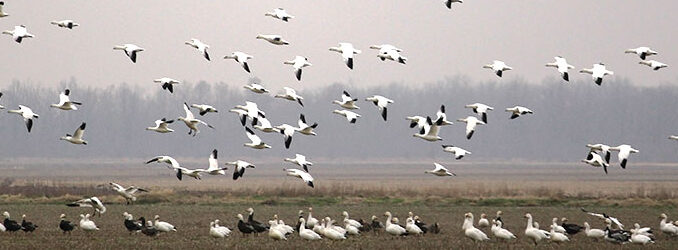
So what happened? Where did 2023 go?
Seemed like it was in a hurry to get someplace. If that someplace was 2024, then 2023 sure wasted a chance at being a good year.
OK, so 2023 wasn’t so good. Record heat, low rainfall leading to record drought, wildfires and dried-up ponds and all of which led to a marsh so dry puddle-duck species more than defined their difference between themselves and their diving-duck cousins.
See, until late December, all our most prized ducks found were puddles in south Louisiana.
Wish granted
Ah, so here we are in 2024 and duck hunters got their wish — albeit late. Miserable cold isn’t what everyone wants, but there are benefits for the outdoors.
Rain pelted our state in December and January, and a polar vortex — a fancy name for bone-chilling cold — swept across the Midwest and came our way. Places up north (isn’t “north” anyplace beyond Shreveport and Monroe?) where our Yankee brethren were wearing short sleeves 30 days before this vortex found themselves struggling to get thermometers to climb past 10 degrees for days on end.
Ferocious Arctic blasts like that push ducks to us, and the last days of the waterfowl season, albeit cold and testing our mettle for a couple of days, added credence to the “all’s well that ends well” adage.
Moreover, what bears mention is this cold snap is part of Mother Nature’s way of handling things. Years ago, maybe too many to count, a climatology instructor pointed out that global temperatures find a balance annually. To wit, an unusually hot summer usually leads to a colder-than-normal winter, if not in the same climatological/seasonal time frame, then certainly over a five-year stretch.
Cold snaps like January’s are good. Maybe not for crawfish or for us old-bone folks, but they help control mosquitoes and nasty salvinia and water hyacinth and such.
Bitter cold also helps hunters. For those with deer days left, it means whitetails have to feed more aggressively to keep enough calories in their bodies to ward off frigid temperatures. More movement means more opportunities for that season-making shot.
For small-game hunters, hard freezes lay low vegetation and make it easier for beagles to chase rabbits, and rid the trees of leaves enough to make spotting squirrels much easier — in addition to rains helping us stay quieter in the woods and not risking snapping a twig to alert every bushytail across three parishes.
Never ending geese
Add to that a conservation order on blue, snow and Ross’ geese that goes to March 5. It’s a bonus season. There is no limit to the number of these species you can take, and you can hunt with unplugged shotguns and use electronic calls. If you’ve never been on one of these hunts, then book one now. It’s thrilling, although with the price of shells, it can get expensive.
Even better, this polar invasion didn’t last long enough or get cold enough to damage our fishing.
Time was we could expect fish kills when a cold front bottomed out near 20 degrees in south Louisiana. Baitfish, speckled trout and redfish showed in fish kills mostly because strong north winds blew water from shallow marshes so rapidly the fish didn’t have a chance to escape to deeper water where they could wait for warmer days.
Freshwater fish always seemed to fare better.
Use time wisely
It’s here where the home-bound fishermen can use this time wisely.
Get all the gear you need for your boat. Make sure signals work, that you have a workable fire extinguisher and life jackets are usable so a safety check doesn’t lead to a citation. Batteries, fuel lines, circuit breakers and wiring needs checking, too.
Get your tackle in order, clean reels, put on new line. The reason being is that the late winter sac-a-lait run and the bass spawn come quickly after a hard winter. I don’t know why, but sometime in February, we’ll see the first run on sac-a-lait show up as soon as the first willow tree sends out green foliage.
Then, barring some unforeseen weather event, coastal fishermen will find speckled trout moving again, usually in deeper water, then waiting for that first warm-up that sends trout into the flats to feed on left-over shrimp and other morsels.
Offshore fishermen find February treasures, too.
It’s now when the big yellowfin tuna and wahoo move into shallower waters off our coast. The veterans know where to find them: the 150-pound-plus tuna and the 80-pound-plus wahoo provide the most adventuresome deep-sea anglers with a reward found in darned few places in our country.
It’s not easy. You have to pick the right time. February can be a bear, but these 29 days can give us gentle-as-a-lamb days when it’s possible to have catches to rival anywhere on our “Big Blue Marble.”
Now, all we have to hope for is a year without hurricanes — a blessing in 2023 — and nothing to repeat 2023’s sweltering heat.
Hope that’s not too much to ask in our prayers. Just keep praying.